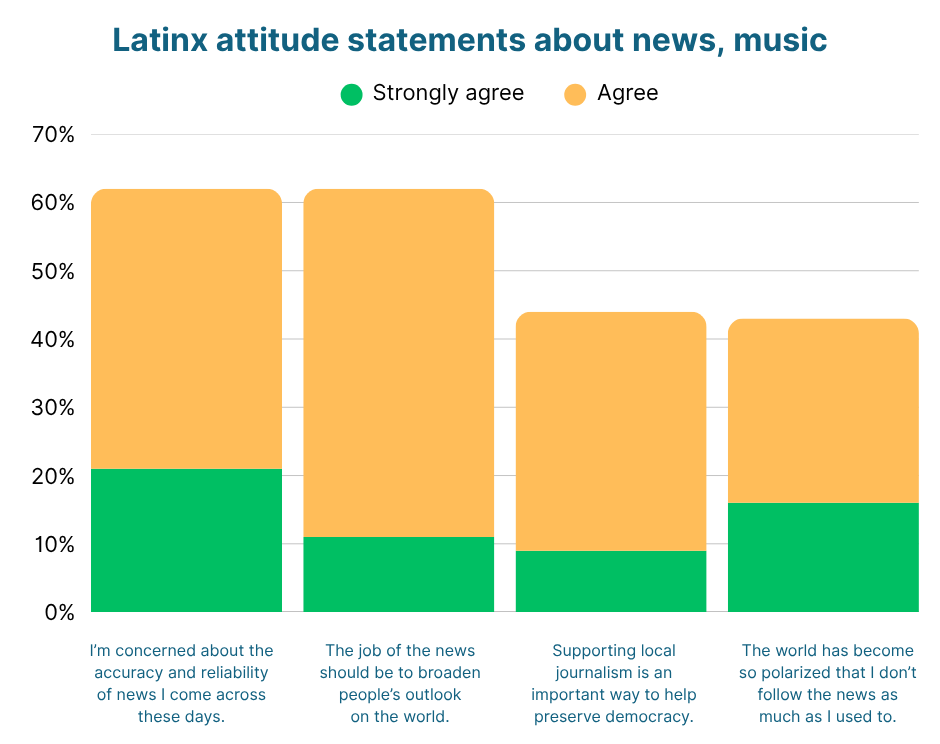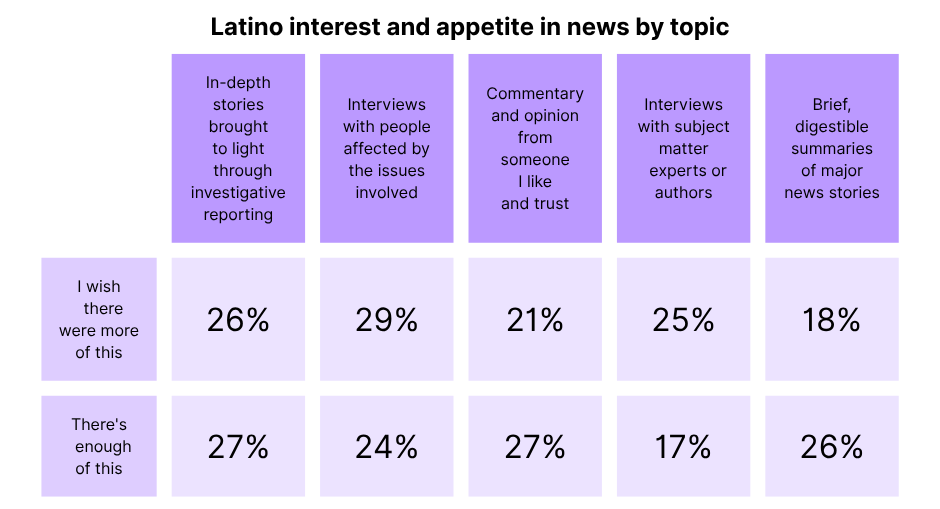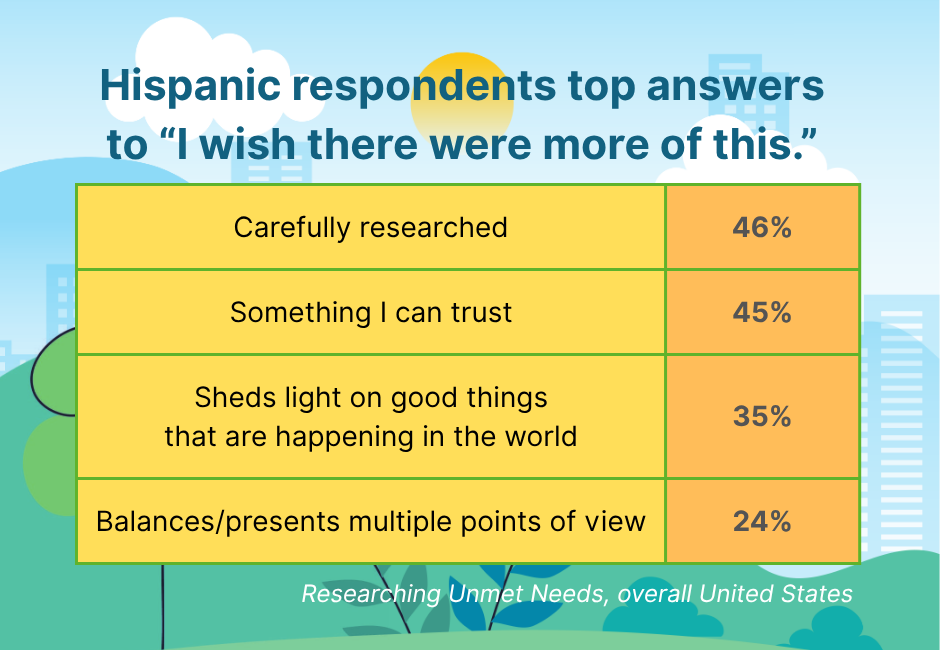Latino audiences, local connection
What the RUN study reveals about serving Latine listeners in your broadcast area
If you work in public media, you’ve probably heard of the Researching Unmet Needs study. The sweeping national survey, released earlier in the year, is a deep dive into what the public says are unmet media needs.
If you’re with a member organization of the Public Media Content Collective (I serve on the board), Station Resource Group (led by the sharp Bill Davis) or Greater Public (the ever-inspiring Joyce MacDonald), you’ve got access to these results. I’ve pored over this data countless times. What stands out are the persistent gaps and the enormous opportunities for public radio to better serve local audiences.
This OIGO, I want to zoom in on what RUN tells us about Latinx audiences nationwide. You can parse the data demographically, and break it down by region. Most public media organizations can’t bankroll local research at this scale, so RUN is an incredible tool to help you think big about your service and act locally.
I can’t urge you enough to revisit or review the full report, if you never have or hadn’t in a minute. Here’s the overview. What pops out as you are seeking insights about Hispanic audiences nationwide?
Localism
Here’s the contradiction that hits hardest: Latino respondents say hyperlocal storytelling is a top priority, yet they also report being chronically underserved in exactly this area. That complaint isn’t a one-off. It points to deeper structural problems in how we do media. At the same time, live, local news and culture is shrinking even as competition for audience attention heats up across new platforms.
Some regions have it even tougher. In the Pacific, West North Central and South Atlantic, the gap between what audiences want and what they get is especially wide. This is more than dollars. It’s about vision, and whether your newsroom sees localism as a differentiator.
Journalism as infrastructure
When you drill into Hispanic participation in RUN, you see something just as powerful. Latine audiences want news that acts as a kind of community infrastructure. They’re looking for content that brings hope, builds belonging, and empowers civic engagement.
This is a big shift from the old model. People want journalism that sparks connection and agency. Such challenges some long-held editorial assumptions. We’re now seeing that our audiences aren’t just looking for a news dump. They want experiences that strengthen their communities. Solution-focused storytelling isn’t just a trend; it’s becoming a necessity.
Of course, there are local flavors to this, but RUN finds some clear, national threads. Latinx audiences across the board are hungry for more in-depth reporting on science, and education. These subjects pop up as less covered everywhere, but especially in the Mountain and East North Central regions. Highlighting these well takes cultural competence and resources, but knowing the need is half the battle.
Immigration, in particular, is both a policy debate and a lived, everyday reality for many. Latino/a respondents say they want stories that recognize these are more than breaking news coverage, but ongoing, human-centered coverage.
If you think this means people want more context, you’re right. Latino respondents are clear: they value journalism that “gets beneath the surface” and tackles issues no one else is covering. This depth gives public radio a real advantage over algorithm-driven models.
Trust is another big theme. Latino audiences are searching for reliable sources and media they see as anchors in a noisy, fragmented information world.
The bad news
There’s a caution though. While Latine respondents believe in the power of local journalism, only 21 percent say they’re aware of public radio, and just 10 percent can name their local station. That’s a jaw-dropping divide and a major opportunity. Where else can you find millions of people whose values align with public radio, but who aren’t yet tuned in? Yet the ones who do engage with public radio report overwhelmingly positive experiences. The barrier isn’t quality. It’s visibility. This is your call to lean into outreach and marketing.
Stuff you may already know
Digital/social platforms: Hispanic audiences show high engagement with YouTube, podcasts and social media. Edison and other researchers have flagged this, and RUN backs it up. The research indicates that media habits are sophisticated, and are deeply rooted in place. For public radio, the challenge (and the sweet spot) is making local content easy to discover and share on the platforms where Latinx audiences are already active.
Music engagement: One more thing you may have heard about previously: music. Latino audiences are famously passionate about music, with streaming dominating, but radio still being strong in the Mountain, West North Central and Southern regions. Genre preferences vary by geography. Hip-hop gets more love out West, for example, while country has broad appeal everywhere. This diversity is an opening to experiment beyond old demographic clichés.
The beauty of RUN is how it lets you slice and dice the data in many ways. If you can access the study, dig in, because you’ll find actionable insights about Latinx audiences in your service area.
The big takeaway? Latino audiences aren’t asking public radio to abandon its core mission. They’re asking us to live up to it more fully. Focus on local relevance, depth and democratic engagement. Success means building content that truly serves and reflects all of our communities. 🟢
Cafecito: stories to discuss ☕
Noticias nuevas. Oregon Public Broadcasting has introduced its new Spanish-language section to the public. Feedback to the team is appreciated! 🖥️
Recognition. The Hispanic Heritage Foundation has named NPR’s Felix Contreras (OIGO profile) as a recipient of the 2025 Hispanic Heritage Award for journalism. 🏆 De Los reports.
Also… Elizabeth Román has been named executive editor at New England Public Media. NEPM offers a formal press release. 🌻
Washington State stories. Washington State University highlights the work of Monica Carillo-Casas in producing stories for Spokane Public Radio and the Spokesman Review in English and Spanish. 📰
Felicidades. KWMR celebrated the two-year anniversary of its Spanish-language program Encuentro Latino with this nice performance posted on Threads. 📯
NALIP creators. The Latine producers’ organization has announced its new cohort of creators chosen for its accelerator program. 🎥 Señal News notes this group is focused on film and television.
DEI exit. Current reports that KQED’s Chief DEI Officer is out amid reorganization and cuts impacting the San Francisco broadcaster. 😔
Spanish podcasts via AI. iHeartMedia is now experimenting with translating select English-language podcasts using AI tools, not staffing. 😑 Spanish is among the languages the company will serve new versions.
False claims and immigration protests. NewsGuard has just released its survey of what Americans believe about false claims that circulate in media. 😈 24 percent of respondents said the claim that bricks were left to arm demonstrators in Los Angeles is true, while 43 percent were unsure.
El radar: try this 📡
See how cities are responding to ICE cooperation. A story from WLRN states Key West’s city leaders voted to cancel agreements for local police to cooperate with federal immigration enforcement. 🚨 Business outcry appears to be a driver. This may be a story to watch locally.
Track immigration enforcement and mental health. A WHYY investigation sought to trace how the vigorous immigration crackdown is affecting Delaware residents’ well-being. 🩺 A valuable story to tell.
Explore the world of photographers capturing Latino community moments. CapRadio profiles a pair of photographers whose specialty is shooting the quinceañera, a rite of passage for Latina girls. 📸 It represents a telling of the Hispanic entrepreneurship story we often hear about, but in a fresh manner.
Or those representing culture in the arts. Enjoy a splendid story from KERA about a local artist using fabrics and sewing to share stories of Latin America. 🪡
Share how nonprofits are supporting Spanish-speaking men and mental health. KUNR reports on Consejo de Líderes: Hombres Unidos, a local support group conducted in Spanish for men to discuss their lives and how to cope with struggles through the day. 🗣️ It’s a thoughtful look at a range of complicated subjects.
Get reactions from leaders at Hispanic serving schools. EdSource captures feedback from administrators at campuses where the majority of students are Latino/a. 🎓 A new lawsuit challenges funding for these institutions, alleging discrimination.
Ask what a local Latine version of The Bear looks like. Making Contact, the syndicated community radio program wrapping up production this fall, did an episode on the hit show The Bear, and, most curiously, what a Latinx version of that might look like. 🥘 It’s a fun exercise that may get you scanning your town for inspiration.
The next OIGO arrives Aug. 15. I often cite Charlotte’s WFAE for its reporting on the region’s Hispanic communities. Next newsletter, I’ll connect you to the reporter leading so much of that effort. Julian Berger is WFAE’s leader covering race and equity, and often helps the organization’s base get to know their neighbors a little bit better. You are in for a treat.
I have a reader survey now open. How can OIGO better serve you? It’s short. Thank you for your insights.
I hope to see you next month at the 2025 Public Media Content Conference. I’ll be in two sessions at this event.
🥤 You can buy me a coffee if you’d like to support the newsletter.









RUN is a stark wake up call for an industry that seems to be constantly trimming Latinx programming and reporting